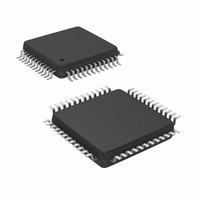DP83848CVV/NOPB National Semiconductor, DP83848CVV/NOPB Datasheet - Page 20

DP83848CVV/NOPB
Manufacturer Part Number
DP83848CVV/NOPB
Description
IC TXRX ETHERNET PHYTER 48-LQFP
Manufacturer
National Semiconductor
Type
Transceiverr
Datasheet
1.DP83848CVVXNOPB.pdf
(84 pages)
Specifications of DP83848CVV/NOPB
Number Of Drivers/receivers
1/1
Protocol
Ethernet
Voltage - Supply
3 V ~ 3.6 V
Mounting Type
Surface Mount
Package / Case
48-LQFP
For Use With
DP83848C-POE-EK - BOARD EVALUATION DP83848CDP83848C-MAU-EK - BOARD EVALUATION DP83848C
Lead Free Status / RoHS Status
Lead free / RoHS Compliant
Other names
*DP83848CVV
*DP83848CVV/NOPB
DP83848CVV
DP83848CVVNOPB
DP83848CVVNOPB
DP83848CVVNOPBTR
DP83848CVVNOPBTR
*DP83848CVV/NOPB
DP83848CVV
DP83848CVVNOPB
DP83848CVVNOPB
DP83848CVVNOPBTR
DP83848CVVNOPBTR
Available stocks
Company
Part Number
Manufacturer
Quantity
Price
Company:
Part Number:
DP83848CVV/NOPB
Manufacturer:
TI
Quantity:
7 600
Company:
Part Number:
DP83848CVV/NOPB
Manufacturer:
NS
Quantity:
4 021
Company:
Part Number:
DP83848CVV/NOPB
Manufacturer:
Texas Instruments
Quantity:
10 000
Part Number:
DP83848CVV/NOPB
Manufacturer:
TI/德州仪器
Quantity:
20 000
www.national.com
2.4.2 LED Direct Control
The DP83848C provides another option to directly control
any or all LED outputs through the LED Direct Control Reg-
ister (LEDCR), address 18h. The register does not provide
read access to LEDs.
2.5 Half Duplex vs. Full Duplex
The DP83848C supports both half and full duplex opera-
tion at both 10 Mb/s and 100 Mb/s speeds.
Half-duplex relies on the CSMA/CD protocol to handle colli-
sions and network access. In Half-Duplex mode, CRS
responds to both transmit and receive activity in order to
maintain compliance with the IEEE 802.3 specification.
Since the DP83848C is designed to support simultaneous
transmit and receive activity it is capable of supporting full-
duplex switched applications with a throughput of up to 200
Mb/s per port when operating in 100BASE-TX mode.
Because the CSMA/CD protocol does not apply to full-
duplex operation, the DP83848C disables its own internal
collision sensing and reporting functions and modifies the
behavior of Carrier Sense (CRS) such that it indicates only
receive activity. This allows a full-duplex capable MAC to
operate properly.
All modes of operation (100BASE-TX and 10BASE-T) can
run either half-duplex or full-duplex. Additionally, other than
CRS and Collision reporting, all remaining MII signaling
remains the same regardless of the selected duplex mode.
It is important to understand that while Auto-Negotiation
with the use of Fast Link Pulse code words can interpret
and configure to full-duplex operation, parallel detection
can not recognize the difference between full and half-
duplex from a fixed 10 Mb/s or 100 Mb/s link partner over
twisted pair. As specified in the 802.3u specification, if a
far-end link partner is configured to a forced full duplex
100BASE-TX ability, the parallel detection state machine in
the partner would be unable to detect the full duplex capa-
bility of the far-end link partner. This link segment would
negotiate to a half duplex 100BASE-TX configuration
(same scenario for 10 Mb/s).
20
2.6 Internal Loopback
The DP83848C includes a Loopback Test mode for facili-
tating system diagnostics. The Loopback mode is selected
through bit 14 (Loopback) of the Basic Mode Control Reg-
ister (BMCR). Writing 1 to this bit enables MII transmit data
to be routed to the MII receive outputs. Loopback status
may be checked in bit 3 of the PHY Status Register
(PHYSTS). While in Loopback mode the data will not be
transmitted onto the media. To ensure that the desired
operating mode is maintained, Auto-Negotiation should be
disabled before selecting the Loopback mode.
2.7 BIST
The DP83848C incorporates an internal Built-in Self Test
(BIST) circuit to accommodate in-circuit testing or diagnos-
tics. The BIST circuit can be utilized to test the integrity of
the transmit and receive data paths. BIST testing can be
performed with the part in the internal loopback mode or
externally looped back using a loopback cable fixture.
The BIST is implemented with independent transmit and
receive paths, with the transmit block generating a continu-
ous stream of a pseudo random sequence. The user can
select a 9 bit or 15 bit pseudo random sequence from the
PSR_15 bit in the PHY Control Register (PHYCR). The
received data is compared to the generated pseudo-ran-
dom data by the BIST Linear Feedback Shift Register
(LFSR) to determine the BIST pass/fail status.
The pass/fail status of the BIST is stored in the BIST status
bit in the PHYCR register. The status bit defaults to 0 (BIST
fail) and will transition on a successful comparison. If an
error (mis-compare) occurs, the status bit is latched and is
cleared upon a subsequent write to the Start/Stop bit.
For transmit VOD testing, the Packet BIST Continuous
Mode can be used to allow continuous data transmission,
setting BIST_CONT_MODE, bit 5, of CDCTRL1 (0x1Bh).
The number of BIST errors can be monitored through the
BIST Error Count in the CDCTRL1 (0x1Bh), bits [15:8].











